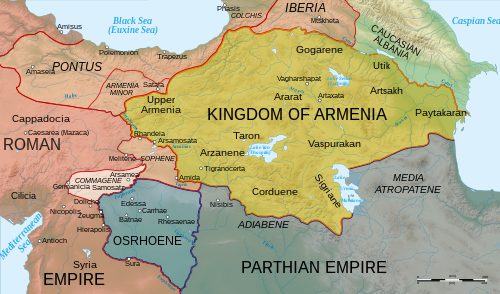Kingdom of Sophene
The Kingdom of Sophene (Armenian: Ծոփքի Թագավորութուն) was an Armenian kingdom, situated between ancient Armenia and Syria. It was ruled by the Orontids, an Armenian[1][2][3][4] dynasty of Iranian[5][6][7][8][9][10] origin. The kingdom was culturally mixed with Greek, Armenian, Iranian, Syrian, Anatolian and Roman influences.[11] Founded around the 3rd century BCE, the kingdom maintained independence until c. 95 BCE when the Armenian Artaxiad king Tigranes the Great conquered the territories as part of his empire.[12] Sophene laid near medieval Kharput, which is present day Elazig.[13]
Kingdom of Sophene Ծոփքի Թագավորութուն | |
|---|---|
| c. 260 BC–95 BC | |
 Map in Sophene in 50 AD (in left) | |
| Capital | Carcathiocerta Arsamosata |
| Common languages | Old Aramaic (government, court)[14][15] Armenian (lingua franca)[16] |
| Religion | Zoroastrianism[17] |
| Government | Monarchy |
| King | |
• c. 260 BC | Sames I |
• c. 95 BC | Artanes |
| History | |
• | c. 260 BC |
• | 95 BC |
Kings of Sophene
- Sames I (ca. 260 BCE)
- Arsames I (ca. 240 BCE)
- Xerxes (ca. 220 BCE)
- Zariadres (ca. 190 BCE)
- Mithrobouzanes (ca. 188 BCE–163 BCE)
- Arkathias (second half of the 2nd century BCE)
- Artanes (or Arsakes) (reign ended ca. 95 BCE)
References
- ↑ Lang, David M (1983). Yarshater, Ehsan (ed.). The Cambridge History of Iran, Volume 3: The Seleucid, Parthian and Sasanian Periods. Cambridge University Press. ISBN 0-521-20092-X. p. 535, "Here a scion of the Armenian Orontid house, King Antiochus I (...) Armenian dynasty of the Orontids."
- ↑ Lang 1983, p. 510.
- ↑ Versluys 2017, p. 48.
- ↑ Maranci 2018, p. 21.
- ↑ Toumanoff 1963, p. 278.
- ↑ Garsoian 2005.
- ↑ Gaggero 2016.
- ↑ Allsen 2011, p. 37.
- ↑ Facella 2021.
- ↑ Russell 1986, p. 438–444.
- ↑ Marciak 2017, p. 77.
- ↑ Marciak 2017, p. 95.
- ↑ Lacey 2016, p. 109.
- ↑ Marciak 2017, p. 117–118.
- ↑ Chaumont (1986), pp. 418–438.
- ↑ Chaumont (1986), pp. 418–438.
- ↑ Boyce & Grenet 1991, p. 320.
Sources
- Marciak, Michał (2017). Sophene, Gordyene, and Adiabene: Three Regna Minora of Northern Mesopotamia Between East and West. BRILL. ISBN 978-90-04-35072-4.
- Lang, David M (1983). Yarshater, Ehsan (ed.). Yarshater, Ehsan (ed.). The Cambridge History of Iran, Volume 3: The Seleucid, Parthian and Sasanian Periods. Cambridge University Press. p. 510. ISBN 0-521-20092-X.
Their royal houses had strong dynastic links with the Armenian Orontid house.
- Gaggero, Gianfranco (2016). "Armenians in Xenophon". Greek Texts and Armenian Traditions: An Interdisciplinary Approach. De Gruyter.
- Toumanoff, Cyril (1963). Studies in Christian Caucasian history. Washington DC. Georgetown University Press. p. 278.
- Lacey, James (2016). Great Strategic Rivalries: From the Classical World to the Cold War. Oxford University Press. ISBN 9789004350724.
- Maranci, Christina (2018). The Art of Armenia: An Introduction. Oxford University Press. p. 20. ISBN 978-0-19-093588-7.
(...) the Armenian dynasty of the Yervandids (Orontids).
- Russell, J.R. (1986). "Armenia and Iran iii. Armenian Religion". Encyclopædia Iranica. pp. 438–444.
- Boyce, Mary; Grenet, Frantz (1991). Beck, Roger (ed.). A History of Zoroastrianism, Zoroastrianism under Macedonian and Roman Rule. Leiden: Brill. ISBN 978-9004293915.
- Allsen, Thomas T. (2011). The Royal Hunt in Eurasian History. University of Pennsylvania Press. p. 37.
- Versluys, Miguel John (2017). Visual Style and Constructing Identity in the Hellenistic World: Nemrud Dağ and Commagene under Antiochos I. Cambridge University Press. p. 48. ISBN 978-1-107-14197-1.
Most scholars assume that Ptolemy was the first Commagenean king and that he descended from the Armenian Orontids.
- Garsoian, N. (2005). "TIGRAN II". Encyclopæedia Iranica.
- Facella, Margherita (2021). "Orontids". Encyclopædia Iranica.